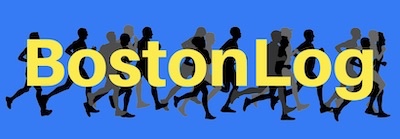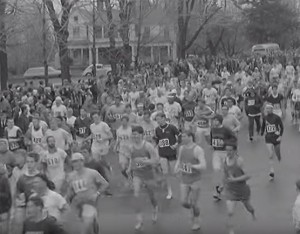Although I was more of a plugger and a plodder than a natural speedster, from an early age I always enjoyed long distance running. While in college during the mid 1960s, I ran cross country for North Carolina State University. However, my first experience running in, or even seeing, a marathon was a new event where I served as both Race Director and official time keeper, the inaugural Greensboro to Winston-Salem Marathon in August 1966. I started this race with the help and encouragement of my friend Fred Hurd, who pointed out those two cities were about 26 miles apart. It was just the second marathon held south of the Mason-Dixon Line. I had to scrape together our $100 budget and then personally recruit all of the runners. When participants questioned how I would be able to both run in the race and be the timekeeper, I told them with a smile “Don’t worry, I’ll wait for you at the finish line!”
My second marathon was five months later, the Durham to Raleigh Marathon in January 1967. Then having done well in my first two long road races, N. C. State sent me up to run the Boston Marathon, paying for my airline ticket there and back. As a college senior, I was already exploring options for graduate school, and I scheduled interviews at the Boston University School of Theology on Tuesday the day after I ran the marathon. The interviews went well and I decided to move to Boston and go to seminary there. I had applied to Duke as well as to Emory and got accepted at all three, but Boston was the place for me to go. I wound up living in Boston for six years while I completed my Masters and Ph.D. degrees.
My first Boston Marathon was a dream come true. I had read about the Boston Marathon for many years and just simply couldn’t believe it when I arrived. As an elementary school kid, I had read about the Boston Marathon in the “Weekly Reader,” and I’d ask people “What direction from Yadkin County, North Carolina, is Boston?” and they’d point north. And I said “Wow, I wonder if I’ll ever go to Boston?” One of the kids in my class, his family moved to Boston for about two or three years, and when he came back to our elementary school, he reported how exciting it was to live in a big city. I’ve always been an avid baseball fan, and I collected Boston Red Sox baseball cards: Ted Williams, the left fielder, homerun champion, and batting champion. Johnny Pesky, their shortstop. And, oh gosh, Dominic DiMaggio there in center field. (The New York Yankees were my top team, but I also respected the Boston Red Sox greats.)
So, I get to Boston, and I’m showing up at the Prudential Center building where the buses are taking the athletes out to the start. I’m over there, looking up at the 52th story of the Prudential Tower, looking up in the sky, feeling like a little bit of a country bumpkin from the tobacco fields of North Carolina. And suddenly a guy grabs me by the arm and says “Get your a___ on the bus now!” (and he wasn’t referring to my ankle either!). It was Jock Semple. So, I snapped to, “Yes, sir!” “Kid, are you going to stand there all day?” So I got on the bus and said “Who in the world is that grumpy old man?” It turned out to be Jock Semple. (I thought I recognized him from pictures I’d seen before.)
So we ride all the way out to Hopkinton, and it’s snowing along the way from Boston. And it’s sleeting, and the wind is blowing, and it’s raining. And here I’ve come from Raleigh, North Carolina, where it’s about 85 degrees, and I’ve just got one little top coat with me. But at least I did bring my sweats along. But when we get to the Hopkinton school gym, you pull off your sweats and put them in a little bag that I had along with me at the time. And then you get to go by a doctor, there checking people’s heart rates, as to whether or not they were healthy enough to run the race. And so I do pass the exam.
The gym is crowded, but I recognize a few of the competitors. I did meet Johnny Kelley the Younger. I didn’t say anything to him; I just stood around in awe. He had won the Boston Marathon in 1957, so I just stood there, and looked at him there in the dressing room. I had run previously in the national 30 kilometer championships in 1966 and 1967, one in Silver Spring, Maryland, and one in Rockville, Maryland. I recognized a few runners from those races. One of them was Lou Castagnola, who had finished very high, maybe fourth, in the 30 kilometers at Rockville, and I had talked to him before. And Ted Corbitt, I’d seen him there in ’66 and ’67, the great African-American distance runner. And so I’d seen some of them in Washington before, but I couldn’t believe how great it was to be there rubbing elbows with over 700 Boston runners!
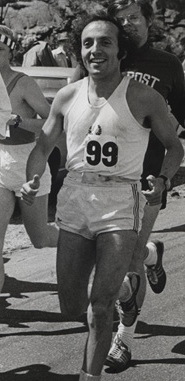
[Erich Segal was probably there, but I wouldn’t have recognized him until after Love Story came out. If my memory serves me correctly, that was in 1970, the movie and the book. I saw him later on, probably about 1971, and got his autograph on my number (borrowing a pen from a fan). Several of us, probably a dozen of us, were surrounding him before the race, and he was signing our race numbers if we wanted them.]
And then we go outside, about an hour to go before the race start. It’s about eleven o’clock, and we stand around outside, shivering. I’ve got a little t-shirt on and a pair of shorts, and shoes and socks, and the temperature is in the 30’s. And the wind is blowing and I’m standing around shivering, and jumping up and down. I’m trying to keep the blood circulating. And then all of a sudden the gun goes off. Oh, wow, here I am, running the dream of my life, the Boston Marathon. I can’t believe it.
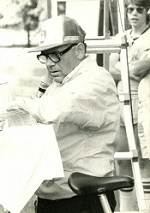
Even with no qualifying time and a very cheap entry fee, I remember seeing unofficial runners or “bandits.” And there were people like Kurt Steiner, a big time AAU official. Kurt Steiner used to love to jump up there on the front line and run the first hundred yards all out, so he could get his picture taken at the starting line: Who’s leading the Boston Marathon. It’s Kurt Steiner, that chubby little AAU official from the New York Pioneer Club or the New York Athletic Club. One or the other. (I think I heard Kurt Steiner was a former French Foreign Legionnaire and/or race walker. He was a Boston fixture.)
Here’s a link to a video of the 1967 Boston. I can’t find myself in it, but I must be there somewhere!
As for me, I jumped in the pack and started running. And I was really pleased with the pace, although it was very, very cold. I was running along in Wellesley, and I looked at my watch, and found I was like 1:27 for the half way time. And I said, “Wow, that means I’m going to break three hours!” So I pick up the pace there past Wellesley College, and through the town of Wellesley. And I start passing people left and right, and oh, I’m feeling super. I can’t believe how fast my legs are running. And there’s a little downhill part going through the town of Wellesley. And there I’m passing all these runners, and then coming out of town, you’re going through the Wellesley hills, then right before you get to the seventeen mile point, you cross over Route 128, and you get to this very hilly section. I’m starting to get a little bit tired at that point, and right after 17 miles, you turn right off of Highway 135 onto Commonwealth Avenue, and then you hit the series of Newton hills. Four or five, going up and down. About half way through the hills, I get a horrible cramp in my left hamstring. It feels like somebody has shot me with a rifle. And, oh gosh, I grab my left hamstring and try to knead out the cramp. I start rubbing it out, and so I am able to get the cramp to go away.
Then shortly thereafter, one of the guys comes by me, and he’s picking up the pace. I introduce myself, I say “I’m Ed Plowman. Where are you from?” He says “I’m Silas Wild.” And I say “Silas Wild, from Reynolds High School, Winston-Salem, North Carolina? I can’t believe that, man. Are you in school now?” He says “Yes. I’m going to Wesleyan University. I’m part of the cross country team at Wesleyan.” I said, “Well, I just finished up at N.C. State, and am about to start the Boston University School of Theology.” So we talked for just a few minutes, then he says “I think I’ll pick up the pace.” So, I said “Go ahead. I’m running more moderate today.”
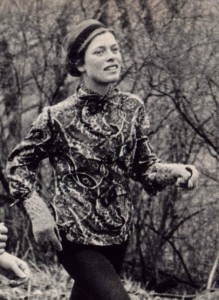
And then another mile up the hills, the cramp hits me again. Doggone it! I grabbed that hamstring, and rubbed it out again. Then I’m running along, and I’m hearing cheering behind me. And I look back behind, and there’s a policeman there on the corner, and he’s on a walkie-talkie, and he says “Hey, Joe. There’s a broad in the race.” And I thought to myself “What a gruff Boston voice that is.”
So I look behind again, and, sure enough, there is a lady running in the race. She has a long flowing brown hair. And I say to myself, “Gosh, I’ve never been in a race with a woman before.” So, that kind of takes my mind off the cramp I’m getting.
So as I’m running along, I’m finally reaching Lake Street, which is near Heartbreak Hill and the 20 mile point. And I can see the Prudential Center, as I’m going down the hill. And I say “Wow, you know, that’s the finish line. Only 10K to go. I got it made. Man, how great it is to see that Prudential Center there on the horizon.” Well, I pick up the pace, going down that hill by Boston College. And I start up another hill before you get to Cleveland Circle. And that old cramp hits me again. Doggone it! Go ahead and massage that cramp. And then you’re following the trolley car. And you’ve got to watch the tracks, or else you can easily break an ankle. It’s rainy. It’s slippery. There’s a bit of snow coming down. But as I start down Cleveland Circle, there’s another downhill part. So I start rolling downhill for about half a mile, and then you turn left off of Commonwealth Avenue onto Beacon Street. And I say it feels good running along here, and the crowds are tremendous, even though the weather is horrible.
So, I go down through there, and I’m looking at all these brownstone houses along the way, and I say “Man, that’s the way I pictured Boston, the Brookline section.” And then the cramp comes back, now about every half a mile, but I stop and rub it out. I say to myself, “By golly, I’m going to finish this race. I ain’t no quitter!”
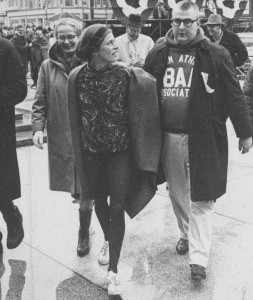
And then I’m heading on down Coolidge Corner, which is within about 5k of the end. And I hear this cheering louder behind me. And I said, “Uh, oh! I bet this lady is gaining on me!” And sure enough, she’s back about 75 yards. It’s Roberta Gibb, and the crowds are going wild. So I said “Hey! They’re cheering for me, too!” So I decided I could pick up my pace a little bit more.
Even though it’s my first time in Boston, I know a little about the geography of the city, and as we’re going across the Massachusetts Turnpike, you can see the CITGO sign ahead. And I say “Hey, just to the right, that will be Fenway Park, gosh, where Ted Williams played.” So, you got a hill going up over the Massachusetts Turnpike, with lots of concrete there. Man, that is tough! But I go down, past that CITGO sign, and say “That’s great, it’s just a mile to the finish now. Man, I’m going to make it if I have to crawl on my ears. There’s no way I’m dropping out now.”
So, people are still waving, and I’m still running through there. It’s still very cold, and I’m shivering. Then we turn from Beacon Street, right again onto Commonwealth Avenue; and then you run underneath Massachusetts Avenue overhead, and you’ve got a little downhill section. And then from there you head on up to Hereford Street, where you take a right turn. And I say “Hey, I think this is going to be the next to the last turn,” but doggone it, you’ve got to run UP a hill on Hereford Street until you get to Boylston. So I say “OK, I can do it!” I reach Boylston, and as I turn left on Boylston Street, then I can see the Prudential Center. Oh, what a glorious sight that is!
So I got this race here in my pocket. I do turn around to see if Roberta Gibb is gaining on me, and at that point she’s nowhere to be seen, because I’ve been running a little faster, and she’s 17 seconds behind. So, I go down Boylston and cross the finish line, and see that clock: three hours and 27 minutes.
I say to myself “Wow, you know, I could have run three hours today, ‘cause I ran 3:18 in January in the Durham – Raleigh marathon, but those cramps, especially on the downhills, pretty well did me in.” On the other hand, man, I’m so glad to finish this race.
And then they’ve got these wool blankets down there, and the next thing I know they’re covering me up with these wool blankets and marching me on into the Prudential Center. I get my little duffle bag there with my sweats in it, and then they’re saying “Hey, there’s beef stew up at the top here,” and there’s the place to catch the elevator up to the floor with the beef stew. Well, I get up there, but it’s more like, how shall I say, by that time a lot of the beef is gone. And it’s hot, it’s so doggone hot. I have to wait there a few minutes, and then there is just a little beef, but I’m so tired I can barely chew it. So I just sit there and say again to myself “Man, I did it!”
That was by first Boston Marathon, 1967. I was 253rd out of approximately 800 runners that year. I’m not sure how many were official or un-official. I’m not sure if that estimate includes bandits or just those officially registered. Roberta Gibb finished a little behind me. It was her second Boston finish. Tom Derderian’s Boston Marathon book says she was 266th (Tom Derderian had a beard and he would always beat me in Boston Marathon. I later ran races around the Boston area so saw him often. He was a better runner than I was, but he was a friendly guy.)
Other finishers included the next year’s winner Amby Burfoot, who, after several time consuming pit stops, was 17th in 2:28. And at almost sixty years of age, John Kelley the Elder ran an amazing 2:58. Lou Castagnola was the first American, placing fourth in 2:17:48. He had done really super well with the 30K championship race earlier that year. I got to D.C. early for that race, and we got to ride around the course together, helping paint some directional arrows on the pavement. Lou was really a nice guy.
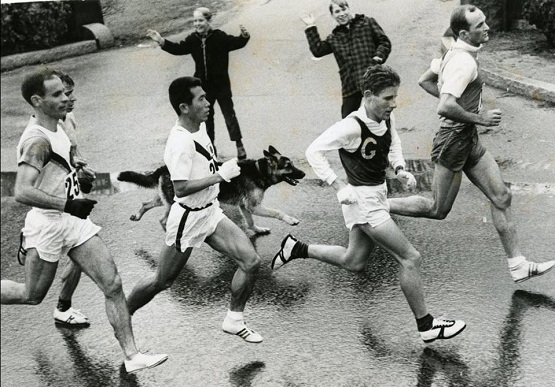
David McKenzie from New Zealand was the race winner in a course record 2:15:45. In the cafeteria of the Pru after the race, he and Bobbi Gibb were the talk of post race chatter. But today, if you google “Boston Marathon 1967,” the first four dozen articles you find will only mention another runner who was considerably behind both Ms. Gibb and I: Katherine Switzer in about 4:20. When her boyfriend was photographed throwing the body block that knocked Jock Semple away from Katherine Switzer, as Jock was trying to grab her official race number, that picture changed long distance running forever.
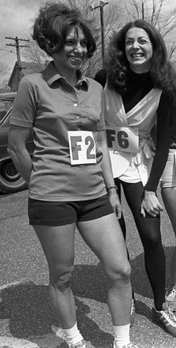
I didn’t get to talk to Katherine Switzer until a few years later, in the early ‘70s. I would talk with her there at the race, and also Sara Mae Berman, from Cambridge. She was another of the early female marathoners. I’d often run against Sara Mae and her husband Larry Berman in several of the local races. I’d be ahead of Sara Mae Berman, but Larry, he was a better runner than me. Sara Mae Berman later became a very good runner, and, of course, Katherine Switzer wound up winning her division of the marathon several years later. She and Nina Kuscsick, from New York, both won it. Later on, I’d go up for the beef stew, and Nina Kuscsick would be up there just laughing and joking, carrying on like she’d just run around the block. Those are good memories.
I moved to Boston in the fall of 1967, and ran the marathon all six years I was in the theology school at BU. Every year I invited guys to come up from the North Carolina Track Club or N.C. State, and it got to be a regular pipeline. Seems like one year, about a dozen guys came up. I would put them up in rooms there at Boston University. I would get several of the theology students who were working the parishes in Massachusetts and New Hampshire, so they’d go away for the weekend, and I’d say “Hey, Sam, Jerry, Bill, you know, I’ve got these guys coming up to run the marathon. Is it alright for them to stay in your room? I’ll get some fresh laundry down there from Bill. We’ll change the sheets on your bed, and afterwards we’ll put your sheets back on. They’ll sleep on the new sheets Bill’s giving me. We won’t bother your towel; I’ll have a towel for them. So I did that all six years I was there in Boston.
Marshall Adams came up just about all of those years (He missed 1972, getting ready for the Olympic marathon trial). Marshall ran a 2:29 in 1970 for 30th place and a 2:31 for 26th place in 1971. Gareth Hayes ran 2:23 for 19th in 1972, and Jack Mahurin 2:25 for 12th in 1973. Our NC State graduates would get a little upset when the crowd would see their “North Carolina Track Club” jerseys, and yell “Go, Tarheels!” confusing the club with the University of North Carolina.
I would take the NCTC runners out, and show them around Boston, and take them to different places to eat, like the Durgin-Park Restaurant, where you’d eat upstairs on the red and white checkered tablecloths. You could get the lamb hocks, you could get chicken pot pie, you could get Yankee pot roast, and all those things. In ‘67, ‘68,’ 69, when I’d take guys to lunch, you’d get the Boston baked beans, then you’d get the mashed potatoes, you’d also get the cup of hot tea, and then you’d get the cornbread, and then they’d have these great big pitchers of water on the table, and you also go New England Indian pudding ice cream, all for 95 cents. But by 1970, the price went up to $1.95.
Durgin-Park was right at the heart of the downtown area, where you might have the mayor of Boston eating at the table, but also a meat packer, or a guy who unloaded fish from the boat in the Boston harbor eating at the same table. You’d have students of Harvard and B.U. and Boston College. You might have a cashier working in Filene’s or Jordan Marsh clothing store. It was fascinating. (When my wife and I ate there in the summer of 2014, when we were back in Boston; we got roast beef for $13.95, and Boston baked beans and mashed potatoes and cornbread, $13.95 and that was a lot of roast beef! That was the luncheon special.)
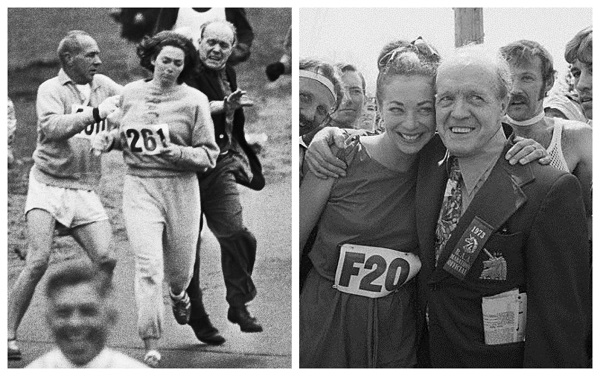
After I moved to Boston for grad school, I got to know Jock Semple quite well. I wanted to sign up to run for Boston Athletic Association. So you had to go down and sign up there with Jock Semple, and I did so with a little bit of fear and trembling. He really was a very nice man. He had a golden heart, even though he was a little bit of a gruff guy. He’d come over in the 1920s from Glasgow, Scotland, and there were not that many opportunities. He came over and became a very good marathon runner and he had different kinds of jobs when he came over. He might have been a ship worker there in Glasgow. Glasgow was the main place for shipbuilding; then ship construction slacked off there through the period of the Depression. But then he became a physical therapist and a very good one. I’m not sure if he was ever professionally trained, but he became the physical therapist and athletic trainer for the Boston Bruins, the ice hockey team, and he became an assistant trainer sometimes for the Boston Celtics basketball team. He had his office there in the Boston Garden down the hall from Red Auerbach, coach of the Celtics.
I was going down to Jock’s office, either on my first or second visit, and I met Red Auerbach in the hallway there in the Boston Garden. I was walking down the hallway he said something like “Son, can I help you?” I say “Yes, sir. I’m going to see Mr. Jock Semple.” And he said “Ah, you’re one of those crazy runners, aren’t you?” And I said “Yes, I am. I run the Boston Marathon.” And he said “Ah, you crazy runners here. Run 26 miles for a bowl of beef stew.” I said, “Yeah, I guess I am.” And he kind of cracked a smile. “Well, okay, follow me. I’ll take you to Jock’s office.” He says “Jock, you’ve got one of those crazy runners here to see you.” Jock said something like “Oh, Red, you know, not all of us are crazy!”
And so I went in to see Jock and signed up for the BAA. I think it was three dollars for a year’s membership. And so I started talking with him and told him I was a theology student at Boston University. “Oh, theology,” he says, “So you’re a minister?” I said, “Yes, I’m a Methodist minister.”
“Oh, well, good.” It so happened Walter Brown the owner of the Boston Garden was receiving a massage from Jock at the time and he said “Well, Jock, if you got a Methodist minister here as a member of the BAA, then you’re going to have to watch your language, and stop your cussing so much.”
Jock said “Awe, I don’t cuss that much. It’s only when I get mad.” So I would go down there in the years afterward to see Jock. I’d had knee pain, and Jock would say “Okay, let me treat that,” and he had a practice he called diathermy treatment. He had this heat lamp he would place, if you had injuries or whatever, you placed that diathermy treatment there, and that lamp would heat your leg. It had some medicinal qualities of the heat, I guess, similar to what ice would do.
And then he’d massage your knee or your hamstring, if you had a calf injury, whatever. And so I would ask him, “What do you charge?” he says “Oh, you’re a minister, I’m not going to charge you.”
Plus there would be races outside of Boston, and as I didn’t have a car while I was in Boston, Jock would say “Well, there’s a race in Gardner, Massachusetts, and it’s about an hour west of Boston. Tell you what, meet me down here at the Boston Garden at, uh, I think the race is going to begin at 10 o’clock, meet me down here at eight o’clock Saturday morning, I’ll give you a ride.” So sure enough, I’d meet him down there, and he’d give me a ride. On the way back, he’d be going to the Boston Garden, if the Bruins were playing that afternoon, he’d say “Okay, I can drop it off on Storrow Drive,” where there’s a pull over at BU, and he’d drop me off right there at the University.
And then there’d be a race out at Attleboro, or there’s be a race from Lexington to Cambridge, and Jock would say “Okay, I’ll be coming by my office, and I’ll give you a ride after, if you want one.” So, he was a good man, but if you offended him, or made him mad, he would let loose with a few “expletives deleted.”
So I was a member of the Boston Athletic Association for all six years in Boston. But I was never a star.
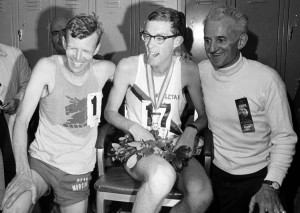
I got to know John Kelley the Younger and John Kelley the Elder. They had the BAA indoor track meet, and the Knights of Columbus indoor track meet, and so I got to know people like Amby Burfoot and Pat McMahon, who finished second to Alvaro Mejia in 1971 by just five seconds. Right after that, Patrick McMahon had a steadily worsening series of injuries and he never raced again.
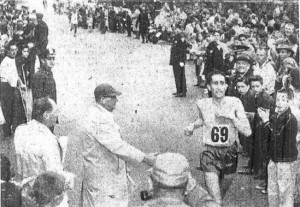
So I got to know these top runners. I would enter the races there, but I would never score. I was not on the BAA first team, I was not on the second team, but I would be like maybe on the third or the fourth team, but there were several other guys there like Al Confalone. He was on the fourth team. He had been on the first team for many years, but was probably, oh gosh, 65 years old at the time. Then there was another guy Ray Counihan, he was on fourth team, too.
I remember one time while I was running, I came by to see Jock Semple to get some diathermy treatment, and Walter Brown was in there, and Mr. Brown said “Who’s that guy again, that came by?” (They thought I had left the room, but I was over in the corner dressing.) Jock said “Oh, that’s Reverend Ed Plowman.” Mr. Brown asked “Oh, he’s a member of the BAA?” “Yeah, he’s a member of the BAA,” Jock said. “He’s not a very good runner, but he likes to run, and he’s a nice guy. He’s the only minister on the team” and Jock said “I call him ‘the Flying Parson’.” [I think Jock copied this after Gil Dodds, the indoor mile record holder back in the 1940s who was also a minister. Dodds would run the Knights of Columbus races and the BAA games].
So, sure enough, Jock would talk with Jerry Nason who was writing these articles for the Boston Globe, and Nason’s column would say “Well, in the race from Hopkinton to Newton, the 20 mile race on Washington’s Birthday, one of the favorites in the race will be Rev. Ed Plowman, the Flying Parson.” And Jock Semple had told him that, I think, because he liked me, but Nason took it like I was going to win it! “One of the favorites in the race!”
I would be talking with John Kelley the Younger in the dressing room there, and he’d say “Well, Ed, I saw in the paper here that you are one of the favorites today.” I said “No, I’ll be running behind you and old John, as well. Jock was just doing that because he’s a nice guy.”
So, I did get to see those guys, but I never did beat either Johnny Kelley the Younger or Johnny Kelley the Elder. I thought I had “the elder” in a Lexington race to Cambridge. I was at about six miles, and I said, you know, I haven’t seen old John today. Then about seven miles, here he comes by me. And, gosh, at the time I was about 24 and he was about 64.
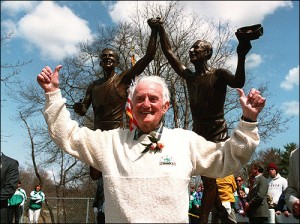
I later became such a good friend of the older Johnny Kelley that I visited him at his home in East Dennis, Massachusetts. Then when he was about 80, he and his wife would come to Florida and live at Sun City Center during January and February. I would have him to come up to Lakeland, Florida. I’d go down and get him; it would be about an hour and a half drive. I’d have him come up and speak to my class I was teaching at Florida Southern College on sport, leisure, and society.
Of course I would tell the students ahead of time. I would be coaching the college’s cross-country runners, and, man, they couldn’t believe here I am bringing in John Kelley the Elder, who made the Olympic team three times, and who won the Boston Marathon in 1935 and 1945! And forty years later, in 1985, he’s still quite a guy and a legend, and he’s coming to speak to my class! Talk about “Young at heart”!
For the six times I ran Boston during grad school, my first race in 1967 turned out to be my fastest. My next best time would have been 3:36. Then the last year I ran it during my Ph.D. studies, I ran 3:41 in 1973 on a very hot day.
While I was in school, the BAA racers formed the core of a nice running community. I remember one time I was running this race with the fourth team of the Boston Athletic Association. There had been a snow storm the day before the race, and it had snowed about eight inches. So we’re running in this race, and we’re not in the front, but we’re in the middle of the pack. There’s a group of us, about eight, going around this corner. Well, there’s a group of about six or eight kids there. The next thing we know, bam! Those snow balls are pelting us, and hitting us, oh gosh, in the head and the chest and everywhere. One of the guys in our pack said, “You know what, let’s go over and beat the crap out of those kids!”
I said “Hey, guys, cool it here. We’re in this race, we don’t want to go over and beat the crap out of those kids. They’re having fun.” “Awe, some fun you call it! Man, that kid hit me square in the face with a snow ball.” I said “Guys, better keep running!” So there’d be occupational hazards like that.
Also, while I was in the School of Theology, I learned theology has to do with converting people. So, my first year there, I converted four guys to become runners. I trained all four along with myself as a team, and I entered our group in the Boston University intramural race, which was held every November. We had to have a name. There was a TV program at the time called the Mod Squad, so I said we’re going to be the BU “God Squad.” And the registration form said each team had to have a coach or a director. The assistant to the dean of the theology school was a lady named Dorothy Lord, so I put down the “BU God Squad” with the Lord as the coach. And we won! We beat every one of the fraternities. We beat the BU Law School, the BU School of Education, everybody! There were always a couple of hot dogs who would take off at the start of a race like that, so I told my team, “Listen folks, I went to NC State and we were the wolfpack, so we’re going to run as a pack.” So we did, and we won.
So here I come in with a pretty substantial trophy from Boston University: Intramural First Place. I come walking into Dean Milder’s office. I’d gotten to know the dean the year before when he interviewed me about coming to BU. I say “Well, Dean Milder, you know I’ve been running with some of the guys since I arrived. Well, here is our trophy.” And he says “Ed, this is pretty impressive. We’re going to put this out here in our display case, right outside my office.” It was a nice big glass display case. I say “Dean Milder, I had to list a coach, too, so I listed Ms. Lord as our coach, so we are the BU God Squad, with Lord as our coach!” And we did that for all three years I was there in the School of Theology. We finished number one. And the Dean had all three of those trophies outside his office.
I later interviewed Dean Milder and said to him “Dean, you’ve been around the School of Theology since the 1920s. Now here it’s the 1960s. Either while you were a student in graduate school, or after you came back in 1945 to become the dean, have you had other people from the School of Theology to run the Boston Marathon?” And he said “No, Ed, you’re the first.” He said “We’ve had people go out and run a mile, I was a miler in college, but 26 miles, no. But I’m impressed with that!” And even later on, after I left BU, the dean said there still were no theology students who had run Boston, so I guess I was the lone groundbreaker.
It’s interesting: in all the years I taught at Florida Southern, none of the religion majors were ever members of our varsity athletic teams. People would say they’re busy reading their Bibles, and they’re praying and concerned with spiritual things. Whereas for me, one time I even thought about writing a book on the theology of running, or religion and meditation, because you always hear talk about the “runner’s high.” People would ask me “Hey, Ed, have you ever thought about praying before you ran a marathon?” I’d say, “Are you kidding me? You think I would go to the starting line and think I was going to run 26 miles without a prayer?” I said, “Boy, I sure do pray!” because I still remember people saying “Hey, you run a whole mile?” How miraculous that was!
Most of the runners in the BAA were Catholic, but as a protestant minister, they accepted me quite well. Sometimes they would want to talk about religion. I’d go out to bars with the guys after a race, or sometimes before the BAA indoor games. I’d have a cup of tea, and they would have either wine or beer, and they’d say “Hey, is it alright if we do that?” and I’d say “Listen guys, I’m satisfied here with tea, and what you all drink, this is your choice.” And they’d say “Well, Okay.”
I think our common ground was that serious running requires a lot of self discipline, and I think a strong spiritual foundation helps give runners that discipline. It was an interesting experience to be a member of the BAA. I liked the guys.
I also got to know several of the guys at the North Medford Club. I believe Tom Derderian was with the North Medford. And then there was a guy, Dave Patrick, a professor at MIT. He would always run the Boston Marathon. I’d see him out training, and we’d run sometimes. I’d train during the lunch time, and he’d be out on a break from teaching physics over at MIT, and we’d run some together.
The Boston winter weather made for some harsh training conditions, especially for someone from North Carolina, and I always eagerly anticipated the early signs of spring. One of the first big races of the year was in February, the Washington Birthday 20 Miler. A Dodge dealer in Newton sponsored it. That was a great run. I ran it every year I was there in Boston. You would run the first 17 miles of the marathon course in from Hopkinton, then where you turned onto Commonwealth Avenue in the marathon, you’d just continue on three more miles straight. There was a Dodge place, down there on the left, where you’d finish. I didn’t have a car, so to get to the start, I took the subway out to the 17 mile point, and then I walked up to three miles to catch the buses that were taking runners out to the start of the race. Then after the race, after running 20 miles, I’d jog back three miles to the subway. So, actually, I had to cover a full marathon that day, when you count the jog and walk three miles getting to the start, then another jog and walk three miles, back to the subway after the finish. But that race was a good tune-up for Boston.
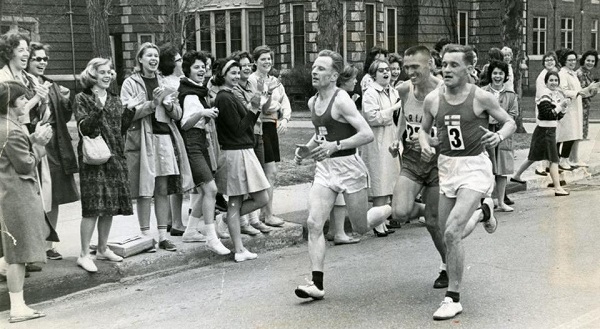
In the late ‘60s, Wellesley College co-eds coming out to watch the marathon was already a well established tradition. Maybe not as slick a production as today, but a big deal on race day, because the girls were always there, supporting the marathoners. They make more signs today. All those Wellesley girls you see today holding signs saying “KISS ME!” We never saw that sort of thing while I was running in the late ‘60s.
I remember the Wellesley girls handing out orange slices. Things like that. They didn’t have Gatorade until about 1970 or ’71. Then they started handing out Gatorade, but before that they did hand out some water. The race was real hot in 1968, and they were handing out cubes of ice, too. I remember sucking on the ice there some. And then I also carried ice from there in my hands.
It was real hot in ’68 and real hot in ‘73. Those were the two hottest years I can remember. It was cold in ‘67, freezing. And then in ‘70 it was freezing. In ‘69, ‘71, and ’72, the race temperature was probably in the upper 70’s.
Today you can follow any runner’s progress on your iPhone. Back in the late ‘60s, they would have an early edition of the newspaper right after the race. By the time I had finished, if the winner was running a 2:22, like Amby Burfoot did in 1968, and I was running over 3:30, by the time I went in and got beef stew, and got back down on the street, the paper would be published, with the results of who had won. But I would hear the results along the way. There would be some guys at about the 20 mile mark, yelling “Hey, so and so won!”
Boston radio – WBZ 103 – would be there broadcasting the race. They had this guy Johnny Most, the announcer for the Boston Celtics. He was famous for his gravelly tones calling the end of Game 7 in 1965: “Havlicek steals it. Over to Sam Jones. Havlicek stole the ball! It’s all over! Johnny Havlicek stole the ball!” He would be announcing the race on the radio.
In the 1970 race, I had a friend tape record the broadcast on one of these large tape recorders. I still have that tape at home in Lakeland Florida, and every now and then, I’ll listen to it:
“As the race progresses, Ron Hill of England is still running in first place. And the guy who is running in second, looks like he is from Georgetown University. What is his name? Is there any chance he’ll catch him?” And Johnny Most said “Well, when you’re running in the rain, you get wet shoes. Wet socks. I imagine his feet are going to be very heavy here towards the end of this race… At this particular point his shoes are getting very heavy, and I think he’s not going to be able to catch Ron Hill from England. This weather is type they like there in England, where it’s cold and it’s wet.”
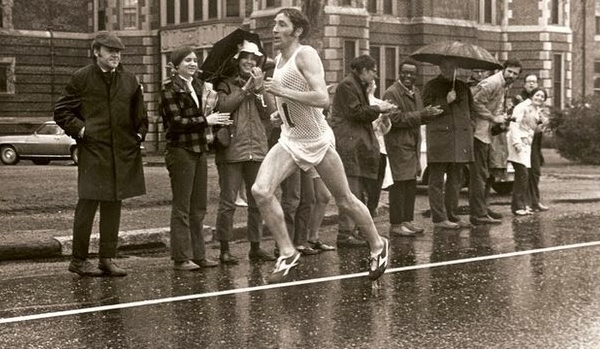
And he was right, although Eamon O’Reilly from Georgetown did take second that year behind Ron Hill in an American record of 2:11:12.
I ran pretty well in 1970. I don’t remember exactly what my time was, but my knee was hurting me that year. I had knee surgery on November 19, 1970, and I did run the Boston Marathon in 1971. I trained real hard from November on, although the orthopedic surgeon said I’d never run again. I said, “Well, I’m going to give it a try!” So I was able to run it, probably in about 4:30, just five months after the surgery. But I was determined to do it. That was my first year working on my Ph.D. degree.
I was always glad to see North Carolina Track Club runners come up from the South: Guys coming up speaking the southern accents. I liked to show off Boston, walk down the Freedom Trail, and shock them with a little bit of Northern culture. Especially take them into Durgin-Park restaurant, with the rude waitresses. The waitresses there were a tradition. If you weren’t insulted by the waitresses at least two or three times, you should feel offended, because they were very brusque.
I remember one time Marshall Adams was there. The waitress barked at him, “Let’s have that order now!” He said “I need to look over the menu a little bit more, I haven’t decided.” She replied “I can’t wait any longer! I can’t wait on you all day! Let’s have that order now!”
But I’d had the Durgin-Park waitress experience the first time I came to Boston. I had my suitcase there beside the table. The waitress said “Get that suitcase out of the way. I’m not going to trip over that old thing. Move it over there in the corner!” So, you kind of get used to that Boston brusqueness.
I moved from Boston in 1973 to High Point College, North Carolina, where I taught for five years. I’d completed my course work, but was still working on my doctorial dissertation: “Social Change in the South since the Second World War, as influenced by the Southern Regional Council (headquartered in Atlanta, Georgia).” I taught all day and tried to write in the evening and on the weekends. With enough procrastinating, it took two and a half years to finish. I traveled throughout the south interviewing people, as well as reviewing the literature on how the SRC had effected social change in the South. I finished up in ‘76, and spent a summer studying at Duke University on a Leather Foundation fellowship. Then I moved to Florida Southern in August of 1978, where I spent the next 37 years.
Over the years, I ran bunches of marathons, 84 in all, including ten at Boston. I ran both in Florida, and in New England (I ran the Cape Cod marathon, the Holyoke marathon, the Hyannis marathon). I also ran the New Jersey marathon and the Marine Corps marathon a couple of times. The last time I ran Boston was in ’97, the year after the 100th one.
I traveled to England 15 times with my students, and I often incorporated marathons into those trips.
I ran in the London marathon in ’87. I ran other marathons in England: the Isle of Wight marathon in 1989, near Portsmouth, where the D-Day invasion started. I ran the Plymouth marathon, where the Pilgrims left for America in 1620. I ran in Southampton, where all the passenger ships use to land. That Southampton marathon was cold, rainy, temperature upper 30s. 40 mile an hour wind off the Itchen River, which flows into the English Channel there in Hampshire. I ran the Poole marathon, the Darby marathon. In fact, once I did four marathons within four weeks. So I really enjoyed running marathons there in England.
There was also the British marathon championship. I did that in ’85, and Ron Hill was there as the guest of honor. So I walked up to Ron Hill at the pasta party the night before the race. I said “Gosh, Mr. Hill, I remember the last time I saw you was fifteen years ago. You won the Boston Marathon in 2:10.” “Yes, that’s right.” He asked “Have you been training much?” I said I’d been training some, that I lived in Florida now.
He asked would I like to come over to his table, and I jumped at the chance! So I go over to the table and there are these various officials over there with Ron Hill and they started questioning me. “Oh, you’re an American? You’re running in the British national championships?” I said yes. “Well, now, are you one of these lads that’s come over to win? An Australian came over last year and won it. Are you planning on winning the British marathon championship this year?” No, I said, I hope to break four hours tomorrow. “Oh, four hours. You came all the way from America to run four hours?” Well, I said, I’ve got a group of about thirty students I’m teaching, over here from Florida Southern. “Four hours?” they replied. I asked them what they thought was going to win the next day? “Oh, probably 2:17 will win.” Well,” I said, “I’ll just wave at the starting line then!”
So I was talking to Ron Hill. (He said “Call me Ron, not Mr. Hill.”) I said you’re one of the few PhD’s in the races here. He said “Yes, that’s right.” He has a Ph.D. in textile chemistry. He talked about the company he’d started, Ron Hill Sports. He said he’d developed various kinds of fibers and wicking fabrics. He was promoting the benefits of synthetic materials for runners, including wrap-over shorts, mesh vests, waterproof running jackets and reflective strips. And he talked about running every day. He kept this log, and hadn’t missed a day of running since December 1964. (At that point he was not even half way to achieving his goal of running at least a mile a day for 50 years straight, which he reached on December 20, 2014.) He was a very meticulous kind of guy, and I enjoyed talking with him.

I also ran the Paris marathon in ’85. That was the 40th anniversary of end of World War II, so that was a big deal. You run the Paris Marathon, starting off there at the Arc de Triomphe, there on Champs-Élysées, running down towards the Place de la Concorde, oh my goodness, and then you’re going by the Eiffel Tower, and you see Avenue Victor-Hugo, and you’re thinking about all these things. And then when you do the London Marathon, you’re starting out at Greenwich, which we use as the point for measuring time, and you’re running past Buckingham Palace, and you’re finishing up there across from Big Ben. And you have to say, that’s quite a little trip for a guy from the tobacco fields and corn fields of Yadkin County, where I started out at age ten working for 25 cents an hour. So, you say “You’ve come a long way, buster!”
And then to also have run the Boston Marathon. Those are all good feelings. But Boston is still my favorite marathon of all. In ‘97 the last year I ran it, it was still a great experience, even though I ran it in about five hours. It was still terrific, to be able to do something like that. Running has been very much a part of my life and soul and spirit; and with the passing of time now some of my best memories.
Ed Plowman
Raleigh, North Carolina
